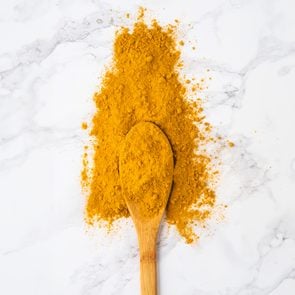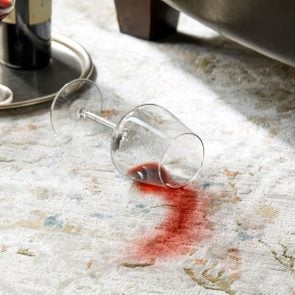How to Get Almost Any Type of Paint Out of Carpet
Updated: May 31, 2024

Don’t panic—we know exactly how to get paint out of carpet. With these expert tips, that acrylic, latex or oil-based paint stain will be a distant memory in minutes.
Uh-oh. You just looked down and realized that in addition to having paint all over your clothes, your formerly pristine carpet looks like an art project gone wrong. Now you’ve got to figure out how to get paint out of carpet. Is it even possible? Yes, experts say, but it’s important to work fast.
First, though, you need to choose the right approach for this type of stain removal, and that really depends on what type of paint has spilled. “Different types of paints contain different ingredients that are designed to adhere to surfaces differently,” says Jennifer Ahoni, a senior scientist at Tide. “They also have varying degrees of water solubility, so the products you may need to remove them can vary.”
We consulted Ahoni, stain-removal expert Mary Marlowe Leverette and Melissa Rodriguez, founder of Bright Home Cleaning SVCS, on how to get acrylic, latex and oil-based paint out of carpet—when it’s wet and when it’s dry. Ahead, you’ll learn their expert tips to remove any type of paint stain and salvage your carpet.
Get Reader’s Digest’s Read Up newsletter for more cleaning, tech, travel, humor and fun facts all week long.
About the experts
|
Before you clean up a paint spill
Before following any steps on how to get paint out of carpet, you’ll need to ask yourself two questions: What type of paint are you dealing with, and is the paint wet or dry? The answers will help you determine how to clean it properly. Let’s explore both.
Determine the paint type
Check the paint label to see if it’s oil-based paint or water-based paint. “The level of stain and how to treat it really depends on the main ingredients of the paint,” Rodriguez explains. Generally speaking, oil-based paints are trickier to remove, since they contain pigments suspended in an oil-based solution that’s resistant to water. These paints create a more durable and long-lasting finish—and that’s also true once they’re embedded in the fibers of your carpet.
Water-based paint can still be difficult to remove, but it isn’t quite as challenging. For example, you may be able to use a more gentle cleaning agent, such as vinegar, to remove freshly spilled water-based paint from carpet, but this technique likely won’t cut it when it comes to oil-based paint.
Determine if the paint is wet or dry
Next, take note of whether the paint is still wet or if it’s dried onto the carpet. “As with most stains, you have a better chance of removing them when they’re still wet,” Ahoni says. “Paint is especially one you want to try to remove wet, as it is designed in most cases to be a semi-permanent or permanent color treatment once dried.” The bottom line is that the quicker you act when removing paint from your carpet, the more successful your efforts will be.
How to get acrylic paint out of carpet

Acrylic paint is a quick-drying, water-based paint made of colored pigment suspended in an acrylic polymer emulsion. If it’s wet now, it won’t be soon, so proceed with the steps below as soon as possible. You can use this technique if you get latex paint on carpet too, since latex is also water-based. Just note that these steps are only for water-based paint stains that are still wet. Dried paint calls for different cleaning supplies and methods, which we’ll address later in this story.
Supplies you’ll need
- Microfiber cloths or sponges
- Dish soap or laundry detergent
- Hot water
- Towel
Step 1: Blot as much as possible
Use a damp microfiber cloth or sponge to blot away as much of the wet acrylic paint as you can. “Be careful not to rub heavily or back and forth, because this can cause the stain to spread and further damage the carpet,” Rodriguez says. Also make sure to use a new portion of the cloth as you blot to prevent spreading the stain or transferring paint back to the carpet.
Step 2: Clean with hot soapy water
Create a homemade cleaning solution of equal parts dish soap or laundry detergent and hot water. Dab the mixture onto the stain with a clean microfiber cloth or sponge to remove any remaining paint. Experts strongly recommend working from the outside edges and moving toward the center to avoid accidentally spreading the paint.
For especially stubborn paint stains, Ahoni says “you can pour detergent directly onto the stain before using a wet sponge or towel to blot it up.” You can also use a 1:1 mixture of vinegar and water instead of (or in addition to) soapy water. Dampen a clean cloth or sponge with the vinegar solution and gently blot the paint stain, working from the outside edges toward the center. Always test the solution in an inconspicuous area first to ensure it doesn’t damage the carpet’s fibers or color.
Step 3: Rinse the carpet
Dip a microfiber cloth in clean water, and rinse the carpet by blotting it repeatedly. Mary Marlowe Leverette, a laundry and stain-removal expert with more than 40 years of experience, stresses the importance of removing all detergent residue. “Leaving soapy residue in the carpet fibers will attract more soil,” she says.
Step 4: Repeat, if necessary
If the stain remains, repeat Steps 1–3.
Step 5: Remove moisture
Once the stain is out, place a clean, dry towel over the wet area. Press your hands over the towel, continuing until the carpet is no longer wet and is only damp. Leaving excess moisture can potentially lead to mildew or mold problems.
How to get oil-based paint out of carpet

To reiterate the bad news, oil-based paint stains are harder to get out than water-based ones because they don’t dissolve easily in water. (This is also why it’s hard to get oil stains out of clothes.) But there is a silver lining: “Oil-based paint has a thicker consistency and therefore will take longer to dry,” Rodriguez says, “so your window of time to clean the spill while it’s still wet is a bit longer as opposed to water-based paint, which dries—and therefore stains—more quickly.”
However, once dry, a simple homemade cleaning solution won’t be enough—you’ll need the help of a solvent like paint thinner or turpentine if you want to get oil-based paint out of carpet.
Supplies you’ll need
- Microfiber cloths, sponges or paper towels
- Paint thinner, paint remover or turpentine
- Dish soap or laundry detergent
- Hot water
- Towel
- Protective gloves
Step 1: Blot as much as possible
“For these types of stains, you want to blot up as much as possible using a cloth,” Ahoni advises. Paper towels work well and can be tossed.
Step 2: Dampen the area
After blotting, use a fresh wet cloth to dampen the area. This will help keep the paint from drying.
Step 3: Treat the stain with a solvent
While wearing protective gloves, dampen a small area of a clean white cloth with paint thinner, paint remover or turpentine. Blot the stained area. Always move to a clean area of the cloth every time you blot, as the paint will transfer from the carpet. Repeat using additional solvent until the stain is gone.
Step 4: Rinse the area
Mix a solution of hot water and a few drops of dishwashing liquid. Dip a sponge or cloth in the solution, and clean away any remaining solvent in the carpet. Finally, use a cloth dipped in plain water to blot away the soapy solution.
Step 5: Remove moisture
Blot away excess moisture with a dry towel. Press on the towel with your hands or feet, and keep moving to a dry area until moisture no longer transfers. Stay off the damp area until the carpet has dried.
How to get dried paint out of carpet

While removing a dried stain requires a bit more elbow grease and some stronger ingredients, you can still get the job done. Rubbing alcohol has solvent properties, so it can soften the paint and break the bond between water-based paint and the carpet, making it easier to remove. Removing dried oil-based paint requires following the same steps recommended for wet oil-based paint; however, it will take more patience.
Supplies you’ll need
- Plastic scraper or old credit card
- Vacuum
- Microfiber cloth or sponge
- Rubbing alcohol (for water-based paint)
- Paint thinner (for oil-based paint)
- Protective gloves
How to remove dry water-based paint
- If latex or acrylic paint is already dry, carefully scrape it off the surface with a plastic scraper or the edge of an old credit card.
- Vacuum up the paint flakes. Do not use water at this stage, or you risk spreading the paint stain.
- Test an inconspicuous portion of the carpet with a small amount of rubbing alcohol. If there’s no color change to the carpet, proceed to the next step.
- Dampen a microfiber cloth with rubbing alcohol, and loosen the rest of the dried paint by gently agitating the carpet with a back-and-forth rubbing motion. Do not press deeply or rub vigorously, and work only within the stained area.
- Once the stain has been removed, blot the area with a damp sponge or cloth until the alcohol smell is gone.
- Finally, remove excess moisture by pressing the area with a clean, dry towel.
How to remove dry oil-based paint
- Start by gently scraping off dry paint from the carpet surface with a plastic scraper or an old credit card. Do not apply any moisture while doing this.
- Vacuum up all the flakes.
- While wearing protective gloves, place a small amount of solvent on a cloth, and blot the stained area. Ideally, the thinner should be one “recommended by the paint manufacturer to help remove and loosen up as much stain as possible,” Ahoni says. Continue blotting, using a new dampened section of the cloth each time you blot. Repeat until the stain has lifted.
-
Dip a microfiber cloth in a warm, soapy solution, and blot the area to remove any traces of the solvent.
-
Dip another cloth in plain water, and wring it until it is not dripping. Blot the area with the cloth until it no longer feels soapy to the touch.
- Remove excess moisture with a clean, dry towel.
How to prevent paint stains in the future
To save your carpet from future paint stains so you never have to frantically google “how to get paint out of carpet” again, Rodriguez suggests applying Scotchgard Water Shield. “It helps protect carpets, rugs and fabrics from absorbing wet stains,” she explains. You’ll still need to wipe up the spill, of course, but it won’t attach itself as stubbornly to the carpet’s fibers if this spray is already acting as a barrier. This will also come in handy with coffee stains, red wine stains and more.
Additionally, both experts say it’s important to put down tarps or drop cloths when working on any project that involves paint. “Always place a drop cloth over your carpet when painting,” Ahoni says, “and make sure it’s well secured to the carpet using tape or weights to prevent it from slipping.”
Rodriguez adds: “Paint specks can travel far, so it’s best to tarp the entire room versus one small area. And, of course, leave potentially messy situations—like your kids’ art projects—to non-carpeted areas!”
Why trust us
At Reader’s Digest, we’re committed to producing high-quality content by writers with expertise and experience in their field in consultation with relevant, qualified experts. For this piece, Maryn Liles tapped her experience as a home and lifestyle journalist, and then Mary Marlowe Leverette, a fabric-care and stain-removal expert with more than 40 years of experience, gave it a rigorous review to ensure that all information is accurate and offers the best possible advice to readers. We also relied on reputable primary sources, including a senior Tide scientist with fabric-care expertise and an experienced home-cleaning professional. We verified all facts and data and backed them with credible sourcing, and we will revisit them over time to ensure they remain accurate and up to date. Read more about our team, our contributors and our editorial policies.
Sources:
- Melissa Rodriguez, cleaning expert and founder of Bright Home Cleaning SVCS; email interview, February 2021
- Jennifer Ahoni, principal scientist for Proctor & Gamble’s Tide; email interview, February 2021
























